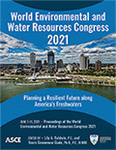Spatial and Seasonal Variations of Disinfection Byproduct (DBP) Precursors in Relation with Total Organic Carbon (TOC)
Publication: World Environmental and Water Resources Congress 2021
ABSTRACT
Disinfection is an essential process for both potable water and wastewater treatment plants. However, disinfection byproducts (DBPs) like trihalomethanes (THMs), haloacetonitriles (HANs), and nitrosamines (NOAs) are formed when organic matter precursors react with disinfectants such as chlorine, chloramine, and ozone. Formation of DBPs is strongly associated with the type of water source, type of disinfectant, and organic matter concentration, which can have seasonal variation. In this study, water samples were collected from 20 different intra-watershed locations, which included urban runoff (with and without the influence of unsheltered homeless populations), wastewater effluent discharges, and a large, terminal reservoir that serves as the local drinking water source. Samples were collected on dry and rainy days, which represent seasonal samples. DBP formation potential (FP) tests were conducted at consistent pH, contact time, and temperature. THMs, NOAs, and HANs were analyzed by gas chromatography-mass spectrometry (GC-MS). The FP tests performed on these water samples revealed that chlorine formed the highest THM concentrations, while THM concentrations were low for the ozone FP test as expected. Chloramine produced the greatest HAN concentrations, with dichloroacetonitrile representing the highest concentration. With respect to sample type, more DBPs were formed at the non-wastewater-impacted runoff sites as compared to the wastewater effluent discharge sites. With respect to TOC levels, rain event samples for all locations had higher TOC concentrations compared to dry sampling days. Similarly, rain event samples showed increased DBP formation; a significant amount of precursors for THMs was found in runoff waters that were influenced by wastewater effluent discharges and unsheltered homeless locations (concentration of total THMs for chlorine FP test was >200 μg/L). Therefore, urban runoff waters should be considered as potential sources of DBP precursors to drinking water source waters, and runoff water is prone to seasonal variation.
Get full access to this article
View all available purchase options and get full access to this chapter.
REFERENCES
Bond, T., Goslan, E. H., Parsons, S. A., and Jefferson, B. (2012). A critical review of trihalomethane and haloacetic acid formation from natural organic matter surrogates. Environmental Technology Reviews. https://doi.org/10.1080/09593330.2012.705895.
Chen, B., and Westerhoff, P. (2010). Predicting disinfection by-product formation potential in water. Water Research. https://doi.org/10.1016/j.watres.2010.04.009.
Chuang, Y. H., and Mitch, W. A. (2017). Effect of Ozonation and Biological Activated Carbon Treatment of Wastewater Effluents on Formation of N-nitrosamines and Halogenated Disinfection Byproducts. Environmental Science and Technology, 51(4), 2329–2338. https://doi.org/10.1021/acs.est.6b04693.
Davison, R. R., Smith, W. H., and Hood, D. W. (1960). Structure and Amine-Water Solubility in Desalination by Solvent Extraction. Journal of Chemical and Engineering Data, 5(4), 420–423. https://doi.org/10.1021/je60008a005.
EPA. (2015). Climate impacts on water resources. US Environmental Protection Agency.
Federation, W. E. (1999). Standard Methods for the Examination of Water and Wastewater Standard Methods for the Examination of Water and Wastewater. Environmental Protection.
Guamán, A., and Yumisaca, H. (2015). Estimated Use of Water in the US in 2015. In USGS. https://doi.org/10.3133/cir1441.
Holady, J. C., Trenholm, R. A., and Snyder, S. A. (2012). Use of automated solid-phase extraction and GC-MS/MS to evaluate nitrosamines in water matrices. American Laboratory.
Hong, H. C., Wong, M. H., and Liang, Y. (2009). Amino acids as precursors of trihalomethane and haloacetic acid formation during chlorination. Archives of Environmental Contamination and Toxicology. https://doi.org/10.1007/s00244-008-9216-4.
Huang, H., Wu, Q. Y., Tang, X., Jiang, R., and Hu, H. Y. (2016). Formation of haloacetonitriles and haloacetamides and their precursors during chlorination of secondary effluents. Chemosphere, 297–303. https://doi.org/10.1016/j.chemosphere.2015.08.082.
Kanan, A., and Karanfil, T. (2020). Estimation of haloacetonitriles formation in water: Uniform formation conditions versus formation potential tests. Science of the Total Environment. https://doi.org/10.1016/j.scitotenv.2020.140987.
Lee, C., and Yoon, J. (2007). UV-A induced photochemical formation of N-nitrosodimethylamine (NDMA) in the presence of nitrite and dimethylamine. Journal of Photochemistry and Photobiology A: Chemistry, 189(1), 128–134. https://doi.org/10.1016/j.jphotochem.2007.01.022.
Lee, W., Westerhoff, P., and Croué, J. P. (2007). Dissolved organic nitrogen as a precursor for chloroform, dichloroacetonitrile, N-nitrosodimethylamine, and trichloronitromethane. Environmental Science and Technology. https://doi.org/10.1021/es070411g.
Mitch, W. A., and Sedlak, D. L. (2004). Characterization and Fate of N-Nitrosodimethylamine Precursors in Municipal Wastewater Treatment Plants. Environmental Science and Technology. https://doi.org/10.1021/es035025n.
Munch, J. W. (1995). Method 524.3: Measurement of purgeable organic compounds in water by capillary column gas chromatography/mass spectrometry.
Perlman, H. (2013). Where is Earth’s water? USGS Water-Science School. U.S. Geological Survey.
Richardson, S. D. (2011). Disinfection By-Products: Formation and Occurrence in Drinking Water. In Encyclopedia of Environmental Health. https://doi.org/10.1016/B978-0-444-52272-6.00276-2.
Sgroi, M., Vagliasindi, F. G. A., Snyder, S. A., and Roccaro, P. (2018). N-Nitrosodimethylamine (NDMA) and its precursors in water and wastewater: A review on formation and removal. In Chemosphere (pp. 685–703). https://doi.org/10.1016/j.chemosphere.2017.10.089.
Tak, S., and Vellanki, B. P. (2018). Natural organic matter as precursor to disinfection byproducts and its removal using conventional and advanced processes: State of the art review. Journal of Water and Health. https://doi.org/10.2166/wh.2018.032.
Trussell, R. R. (1978). FORMATION OF TRIHALOMETHANES. Journal/American Water Works Association. https://doi.org/10.1002/j.1551-8833.1978.tb04255.x.
USDA. (2016). Irrigation & Water Use. United States Department of Agriculture, Economic Research Service.
Yang, L., Chen, X., She, Q., Cao, G., Liu, Y., Chang, V. W. C., and Tang, C. Y. (2018). Regulation, formation, exposure, and treatment of disinfection by-products (DBPs) in swimming pool waters: A critical review. In Environment International. https://doi.org/10.1016/j.envint.2018.10.024.
Zeng, T., Glover, C. M., Marti, E. J., Woods-Chabane, G. C., Karanfil, T., Mitch, W. A., and Dickenson, E. R. V. (2016). Relative importance of different water categories as sources of N-nitrosamine precursors. Environmental Science and Technology. https://doi.org/10.1021/acs.est.6b04650.
Information & Authors
Information
Published In
Copyright
© 2021 American Society of Civil Engineers.
History
Published online: Jun 3, 2021
Authors
Metrics & Citations
Metrics
Citations
Download citation
If you have the appropriate software installed, you can download article citation data to the citation manager of your choice. Simply select your manager software from the list below and click Download.
